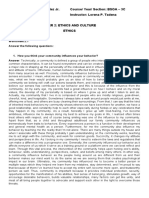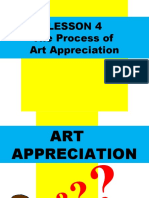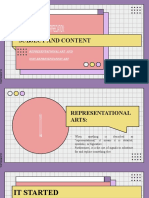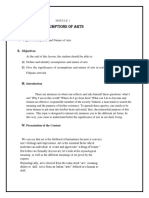Four Common Essentials, Assumptions, and Functions
Four Common Essentials, Assumptions, and Functions
Uploaded by
KarenMarantalCopyright:
Available Formats
Four Common Essentials, Assumptions, and Functions
Four Common Essentials, Assumptions, and Functions
Uploaded by
KarenMarantalOriginal Title
Copyright
Available Formats
Share this document
Did you find this document useful?
Is this content inappropriate?
Copyright:
Available Formats
Four Common Essentials, Assumptions, and Functions
Four Common Essentials, Assumptions, and Functions
Uploaded by
KarenMarantalCopyright:
Available Formats
Republic of the Philippines
Laguna State Polytechnic University
Province of Laguna
Course GEC 106: Art Appreciation
Sem/AY ISO First
9001:2015 Semester/2020-2021
Certified
Level I Institutionally Accredited
Module No. 3
Lesson Title FOUR COMMON ESSENTIALS, ASSUMPTIONS, AND FUNCTIONS
Week Duration WEEEK 4
Date October 26-31, 2020
Description of the The lesson that will be discussed is showing how the art existed, importance of
Lesson valuing it, and essence of developing the creativeness of an artist. The great
connection of art in the lives of the people will be also emphasized.
Lecture Guide
FOUR COMMON ESSENTIALS OF ART
Art has to be man-made.
Art must be creative, not imitative.
Art must benefit and satisfy man.
Art is expressed through a certain medium or material by which the artist communicates
himself to his audience.
ASSUMPTIONS OF ART
There are principles and bases of appreciating a work of art since it is in art that man can
communicate one’s individuality and way of life.
A. ART IS UNIVERSAL
B. ART IS NOT NATURE
GEC 106 ART APPRECIATION LSPU-SPCC
Republic of the Philippines
Laguna State Polytechnic University
Province of Laguna
Art is everywhere; wherever men have lived together, art has sprung up among them as a
language charged withCertified
ISO 9001:2015 feelings and significance. Art has no limit, and it rises above cultures,
Level I Institutionally Accredited
races, and civilization. It is timeless because it goes beyond the time of our existence.
The first assumption then about the humanities is that art has been crafted by all people
regardless of origin, time, place, and that is stayed on because it is liked and enjoyed by people
continuously. A great piece of art will never be obsolete.
Some people say that art is art for its intrinsic worth. In John Stuart Mill’s Utilitarianism (1879),
enjoyment in the arts belongs to a higher good, one that lies at the opposite end of base
pleasures.
Art will always be present because human beings will always express themselves and delight in
these expressions. Men will continue to use art while art persists and never gets depleted.
Generally, art is present in very part of the globe and in every time period. This is what is
meant by its universality.
B. ART IS NOT NATURE
a. Art is man-made; it is a creation of man utilizing his thoughtful skill and artistry, which
undergoes process and planning.
b. Art is artificial -because it is just an imitation or even an appropriation of reality and nature.
Art that is created by God is divine, and art that is created by man is superficial or temporary.
c. Art Can Never Be Natural -because it is momentary in the constant transformation of change;
it does not change by itself unless manipulated by its creator, which is man.
d. From man’s experiences, we cannot even compare Art with Nature because it is something
mysterious and it is made by the Divine Providence whose depth and mystery is beyond
human understanding.
C. ART INVOLVES EXPERIENCE
Art is a depiction of our experiences. It demands taking part. Art involves laying of pigments,
molding of clay, chipping of marble, casting of bronze, constructing of buildings, singing of
songs, playing roles on stage, acting, and going through rhythmic movements in a dance. We
can only appreciate art if we spend time to look at it, listen to it, touch it, and feel its
presence.
Dudley et al., (1960) affirmed that “all art depends on experience, and if one is to know art,
he must know it not as fact or information, but as experience.” A work of art then cannot
be abstracted from actual doing. In order to know what an artwork is, we have to sense it,
see or hear it.
To fully appreciate our national hero’s monument, one must go to Rizal Park
and see the actual sculpture.
In matters of art, the subject’s perception is of primacy.
You may read a lot of reviews about Family History, or your friends may talk
about it in front of you. You will not know the movie until you experience it.
GEC 106 ART APPRECIATION LSPU-SPCC
Republic of the Philippines
Laguna State Polytechnic University
Province of Laguna
An important aspect of experiencing art is its being highly personal, individual, and
subjective. ISO
In9001:2015
philosophical
Certified terms, perception of art is always a value of judgment. It
Level I Institutionally Accredited
depends on who the perceiver is, his tastes, his biases, and what he has inside him.
(Degustibus non disputandum est) Matters of taste are not matters of dispute. One cannot
argue with another person’s evaluation of art because one’s experience can never be known
by another.
FUNCTIONS OF ART
1. PERSONAL FUNCTION
A. It is being used to provide comfort, happiness, and convenience to human beings.
B. The artist tries to express his personal feelings through the artwork.
C. To express beauty
D. It gives man moment of relaxation and spiritual happiness
E. It serves as a channel of man’s passion.
F. Overcomes the feelings of restlessness and loneliness
2. SOCIAL FUNCTION
Art is used for public display and celebration; it is used to affect collective behavior. It
bridges connection among people. Art conveys sense of family, community, or civilization.
3. CULTURAL FUNCTION- Art helps preserve, share, and transmit culture of people from one
generation to another.
Egyptian Hieroglyphs
Hieroglyphic carvings and paintings on the interior walls of an ancient Egyptian temple in Dendera
Cuneiform
A system of writing first developed by the ancient Sumerians of Mesopotamia c. 3500-3000 BCE
Mesoamerican Pyramids
Structures form a prominent part of ancient Mesoamerican architecture. Although similar to each
other in some ways these New World structures with their flat tops (many with temples on the top)
and their stairs bear only a very weak architectural resemblance to Egyptian pyramids.
Machu Picchu
A 15th century Inca citadel, located in the Eastern Cordillera of southern Peru, on a 2,430-metre
(7,970 ft) mountain ridge.[11][12] It is located in the Cusco Region, Urubamba Province, Machupicchu
District,[13] above the Sacred Valley, which is 80 kilometres (50 mi) northwest of Cuzco and through
which the Urubamba River flows, cutting through the Cordillera and creating a canyon with a
tropical mountain climate.
GEC 106 ART APPRECIATION LSPU-SPCC
Republic of the Philippines
Laguna State Polytechnic University
Province of Laguna
Leaning Tower of Pisa
The campanile, orISOfreestanding bell
9001:2015 Certified tower, of the cathedral of the Italian city of Pisa, known
Level I Institutionally Accredited
worldwide for its nearly four-degree lean, the result of an unstable foundation
Borobudur
Borobudur is a 9th-century Mahayana Buddhist temple in Magelang Regency, not far from the town
of Muntilan, in Central Java, Indonesia. It is the world's largest Buddhist temple.
4. AESTHETIC FUNCTION
Art becomes influential for man to be aware of the beauty of nature. Aesthetic is when
there is the real feelings of appreciation to nature’s beauty and are manifested through
appreciation and enjoyment when in contact with the artwork.
5. SPIRITUAL FUNCTION
An artist may create a work of art to reinforce the religious or spiritual support of a culture.
GEC 106 ART APPRECIATION LSPU-SPCC
You might also like
- Lesson 1 and 2 PPT Art AppreciationDocument41 pagesLesson 1 and 2 PPT Art AppreciationAngel CastilloNo ratings yet
- Nature and Functions of ArtDocument23 pagesNature and Functions of ArtRea Mae GohetiaNo ratings yet
- Art Appreciation: "Withdraw Into Yourself Truth Dwells in The Inner Man."Document5 pagesArt Appreciation: "Withdraw Into Yourself Truth Dwells in The Inner Man."John Fernand RacelisNo ratings yet
- Scribbling SoulDocument8 pagesScribbling Souldaniela FugataNo ratings yet
- GE 111: Understanding The Self - Module Content - Week 8 - Lesson: Module 3Document4 pagesGE 111: Understanding The Self - Module Content - Week 8 - Lesson: Module 3It's me CathyNo ratings yet
- Chapter 2: Functions of Art: Arts AppreciationDocument8 pagesChapter 2: Functions of Art: Arts AppreciationFuentes, Ferdelyn F.No ratings yet
- Easy Japanese (Japanese Phrasebook) - TuttleDocument189 pagesEasy Japanese (Japanese Phrasebook) - TuttleKarenMarantal88% (8)
- Four WheeldriveDocument40 pagesFour Wheeldrivesantosh.acfNo ratings yet
- GE6 Lesson 1-Art AppreciationDocument3 pagesGE6 Lesson 1-Art AppreciationNiña Amato100% (1)
- Ge116 Art Appreciation ModuleDocument85 pagesGe116 Art Appreciation ModuleGodwin Pareñas-Mallorca RoderoNo ratings yet
- Cultural and Intercultural Modes of CommunicationDocument23 pagesCultural and Intercultural Modes of CommunicationJhoy LamosteNo ratings yet
- Art Appreciation Module 3Document2 pagesArt Appreciation Module 3Michael Anthony EnajeNo ratings yet
- Lesson-6 Levels and Meaning of SubjectDocument35 pagesLesson-6 Levels and Meaning of SubjectChat GazaNo ratings yet
- Classical Period ArtDocument39 pagesClassical Period ArtGeraldJadeLazaro100% (1)
- Do All Arts Express BeautyDocument8 pagesDo All Arts Express BeautyCaryl EmpuertoNo ratings yet
- Some Notable Filipino Artists (PARADO)Document4 pagesSome Notable Filipino Artists (PARADO)Juzz Casiano ParadoNo ratings yet
- Lesson I: Introduction To Humanities and Art AppreciationDocument9 pagesLesson I: Introduction To Humanities and Art AppreciationJoyce Kayen BuisingNo ratings yet
- Ethics Chapter 2 BSOA-3CDocument10 pagesEthics Chapter 2 BSOA-3CRogelio Olasos BernobaNo ratings yet
- MODULE 3 - Art AppreciationDocument5 pagesMODULE 3 - Art Appreciationmenard3jonas3barboniNo ratings yet
- Basic Assumptions, Functions and Nature of Arts: Art Is An Expression Made Visible by FormDocument11 pagesBasic Assumptions, Functions and Nature of Arts: Art Is An Expression Made Visible by FormJulia Stefanel PerezNo ratings yet
- Lecture 4. Process of Art AppreciationDocument34 pagesLecture 4. Process of Art AppreciationCharmaine JanorasNo ratings yet
- Subject and Content: Representational Art and Non-Representation ArtDocument16 pagesSubject and Content: Representational Art and Non-Representation ArtEsperance LanuzaNo ratings yet
- Unit 2 Lesson 3 Art Appreciation and The Human FacultiesDocument3 pagesUnit 2 Lesson 3 Art Appreciation and The Human FacultiesCecile Therese Nuñez-MarcojosNo ratings yet
- Lesson 1 Art AppreciationDocument21 pagesLesson 1 Art AppreciationMaeNo ratings yet
- Module 3: Subject and Contents of ArtDocument5 pagesModule 3: Subject and Contents of ArtKez0% (1)
- Artists Vs ArtisanDocument4 pagesArtists Vs ArtisanPatrice Danielle Lim100% (1)
- Reflection ArtDocument4 pagesReflection ArtDianaNo ratings yet
- Lesson 6 - Function in The ArtsDocument10 pagesLesson 6 - Function in The ArtsShina Mae Abellera Barrameda50% (2)
- The Purpose of Art AppreciationDocument3 pagesThe Purpose of Art AppreciationdfghrtNo ratings yet
- I. Topic: Assumptions and Nature of ArtsDocument15 pagesI. Topic: Assumptions and Nature of ArtsJulian CasibangNo ratings yet
- Week 2 - Art Appreciation and Assumptions of ArtDocument14 pagesWeek 2 - Art Appreciation and Assumptions of ArtMarkNo ratings yet
- My Encounter With Arts Why?Document2 pagesMy Encounter With Arts Why?JohnPaul Vincent Harry Oliveros100% (1)
- GEC 5 Art Appreciation ModuleDocument48 pagesGEC 5 Art Appreciation ModuleEll Mae100% (1)
- Chapter 1 Functions of ArtsDocument32 pagesChapter 1 Functions of ArtsKezia GwynethNo ratings yet
- Subject and ContentDocument57 pagesSubject and ContentJoe Carl CastilloNo ratings yet
- ART APPRECIATION HandoutsDocument143 pagesART APPRECIATION HandoutsAlpha Parman BagorioNo ratings yet
- Activity 1 - Assumptions About ArtDocument3 pagesActivity 1 - Assumptions About ArtJosephine Olaco100% (1)
- Don Carlos Polytechnic College Ge 8: EthicsDocument4 pagesDon Carlos Polytechnic College Ge 8: EthicsChen Maglunsod100% (1)
- Art Appreciation Module 1Document10 pagesArt Appreciation Module 1Zerrudo, Glen Dale100% (1)
- How Can You Utilize The Arts To Express YourselfDocument1 pageHow Can You Utilize The Arts To Express YourselfAngel Lavine100% (2)
- STS ReportDocument12 pagesSTS ReportSensen Galang100% (1)
- Lecture 3.1 - The Field of AestheticsDocument16 pagesLecture 3.1 - The Field of AestheticsAser Ser100% (1)
- Auditory and Combined ArtsDocument2 pagesAuditory and Combined ArtslunatheworldNo ratings yet
- Chapter 6-Art HistoryDocument16 pagesChapter 6-Art Historyklause SalamanNo ratings yet
- MODULE TOPIC 2 GEC 5-Art-AppreciationDocument5 pagesMODULE TOPIC 2 GEC 5-Art-AppreciationJayArt Amogis TemPoral100% (1)
- MODULE 3: Rediscovering Philippine Art: Topic OutlineDocument6 pagesMODULE 3: Rediscovering Philippine Art: Topic OutlineTrisha HoraNo ratings yet
- Gec 4 Lesson 7 Arts and ArtisanDocument21 pagesGec 4 Lesson 7 Arts and ArtisanGian Jane QuiñonesNo ratings yet
- Art Appreciation Lesson 2Document5 pagesArt Appreciation Lesson 2Lexie KepnerNo ratings yet
- Information Revolution: Villajin, Nikki Loren C. Mañalac, Kurt Russel PDocument12 pagesInformation Revolution: Villajin, Nikki Loren C. Mañalac, Kurt Russel PKurtNo ratings yet
- NSTPDocument3 pagesNSTPPriity Precious100% (1)
- Subject and Content1Document21 pagesSubject and Content1ber tingNo ratings yet
- Artist and ArtisanDocument3 pagesArtist and Artisanjingky SallicopNo ratings yet
- Math As A LanguageDocument5 pagesMath As A LanguageYolly Alcala AvilaNo ratings yet
- Embracing The HumanitiesDocument10 pagesEmbracing The HumanitiesAna May Baniel100% (3)
- Functions of ArtsDocument23 pagesFunctions of ArtsJayCruzNo ratings yet
- Ge 6-At7Document3 pagesGe 6-At7jennie kyutiNo ratings yet
- Categories Classifications of ArtDocument5 pagesCategories Classifications of ArtKarenMarantalNo ratings yet
- Module 1 - Art AppreciationDocument11 pagesModule 1 - Art Appreciationjhem villorente100% (1)
- Gec106 - Module 2023Document64 pagesGec106 - Module 2023Chavie MagallanesNo ratings yet
- MODULE 1 Assumptions Nature Functions and Philosophy of Art(1)Document12 pagesMODULE 1 Assumptions Nature Functions and Philosophy of Art(1)ballogancharissaNo ratings yet
- Art Appreciation Lecture 1Document18 pagesArt Appreciation Lecture 1Cresenciano Malabuyoc100% (1)
- Art App Modules 1-4 PDFDocument31 pagesArt App Modules 1-4 PDFKHAIRABAI BAGUILAN100% (1)
- Seed Paper Carrier Bag: Plaridel Integrated National High School Barangay Banago Nagcarlan, LagunaDocument5 pagesSeed Paper Carrier Bag: Plaridel Integrated National High School Barangay Banago Nagcarlan, LagunaKarenMarantalNo ratings yet
- FINAL PPT CONCEPTpaperDocument11 pagesFINAL PPT CONCEPTpaperKarenMarantalNo ratings yet
- Rufo, Villy G. 2bsba - Mm2Document1 pageRufo, Villy G. 2bsba - Mm2KarenMarantalNo ratings yet
- Categories Classifications of ArtDocument5 pagesCategories Classifications of ArtKarenMarantalNo ratings yet
- NR-420803-Computer Application in Chemical EnggDocument7 pagesNR-420803-Computer Application in Chemical EnggSrinivasa Rao GNo ratings yet
- Motors Buyer GuideDocument72 pagesMotors Buyer GuideUmar MurtazaNo ratings yet
- Catalogue - Proflex Disc DiffuserDocument2 pagesCatalogue - Proflex Disc DiffuserAzhar MandhraNo ratings yet
- 2nd Week NotesDocument22 pages2nd Week NotesWendelyn YtolNo ratings yet
- Linear Algebra - Jin Ho Kwak & Sungpyo HongDocument398 pagesLinear Algebra - Jin Ho Kwak & Sungpyo HongDiyanko Bhowmik25% (4)
- Factors Affecting Reading Comprehension of Grade V Pupils in Kitang Elementary SchoolDocument30 pagesFactors Affecting Reading Comprehension of Grade V Pupils in Kitang Elementary SchoolCes Dt88% (80)
- CIRE 2131: Lab 9: Optoelectronic DevicesDocument6 pagesCIRE 2131: Lab 9: Optoelectronic Devicesapi-314700913No ratings yet
- A2: CRT K (Afro-Pessimism, Anti-BlacknessDocument5 pagesA2: CRT K (Afro-Pessimism, Anti-BlacknessmatthewleedavisNo ratings yet
- Vijaya Sree PPT 2 CDFDDocument44 pagesVijaya Sree PPT 2 CDFDsai krishnaNo ratings yet
- O The Teacher Will AskDocument2 pagesO The Teacher Will AskJasellay Camomot100% (1)
- Altoids USB Battery Tutorial: by Jonathan ShanDocument9 pagesAltoids USB Battery Tutorial: by Jonathan ShanSyahrum MubarakNo ratings yet
- Why People Should Take Part in Volunteering Work? (150-180w)Document3 pagesWhy People Should Take Part in Volunteering Work? (150-180w)Minh NguyệtNo ratings yet
- Lab. AgregadosDocument37 pagesLab. AgregadosRichard Choque VasquezNo ratings yet
- Final List of Successful Bidders in RESCO Model - 1000MW RT - Phase-IDocument5 pagesFinal List of Successful Bidders in RESCO Model - 1000MW RT - Phase-IParmenderNo ratings yet
- Lekhani Chirwa Wins Inaugural Wyllie Longmore AwardDocument1 pageLekhani Chirwa Wins Inaugural Wyllie Longmore AwardAiden CondronNo ratings yet
- Understanding The LearnersDocument9 pagesUnderstanding The LearnersNicole RomeroNo ratings yet
- English Proficiency Test'Document12 pagesEnglish Proficiency Test'ailaine grace alap50% (4)
- YES! Brochure 2023-24Document8 pagesYES! Brochure 2023-24dleeNo ratings yet
- Ace Endostare AzureDocument2 pagesAce Endostare Azureiulian tigauNo ratings yet
- K ULOMETRIDocument49 pagesK ULOMETRIRudi April AntoNo ratings yet
- Server-Sent Events in FastAPI using Redis Pub_Sub _ DeepdeskDocument12 pagesServer-Sent Events in FastAPI using Redis Pub_Sub _ DeepdeskWonderZaidNo ratings yet
- Service: Air Conditioner With Refrigerant R134aDocument383 pagesService: Air Conditioner With Refrigerant R134asven cornelissensNo ratings yet
- Management IntroductionDocument41 pagesManagement IntroductionRagnar LothbrokNo ratings yet
- Rojgar Mela CVDocument19 pagesRojgar Mela CVGanga Bdr BishwakarmaNo ratings yet
- Crud HelloDocument4 pagesCrud Helloudayrangpariya2003No ratings yet
- Samville Studio Profile 2023Document43 pagesSamville Studio Profile 2023SAS IndonesiaNo ratings yet
- JurnalDocument8 pagesJurnalobetNo ratings yet
- Q&H Report NEXODocument17 pagesQ&H Report NEXOMadan MouryaNo ratings yet
- Chaitanya IntroductionDocument7 pagesChaitanya Introductionanon_647217551100% (1)





























































































